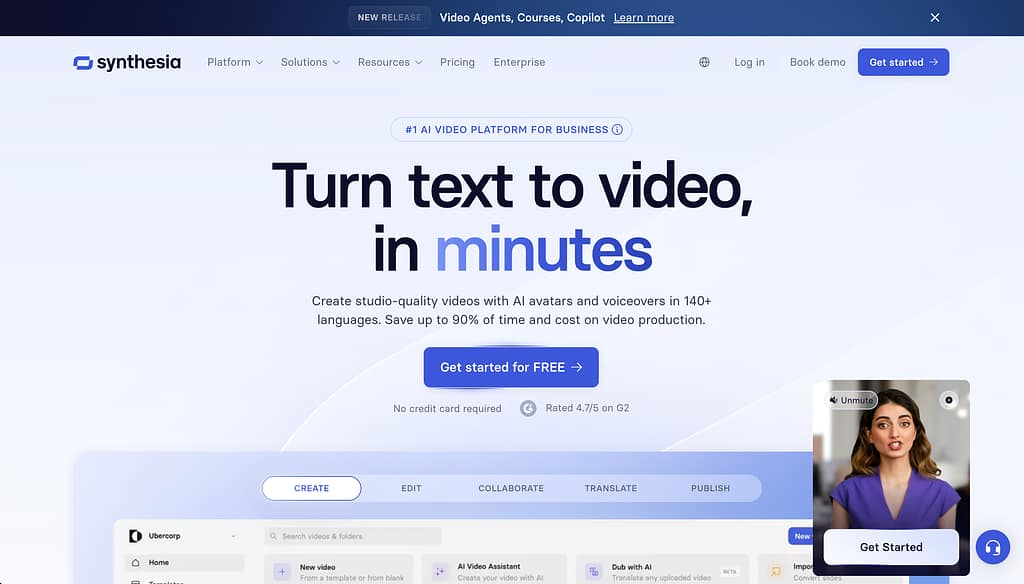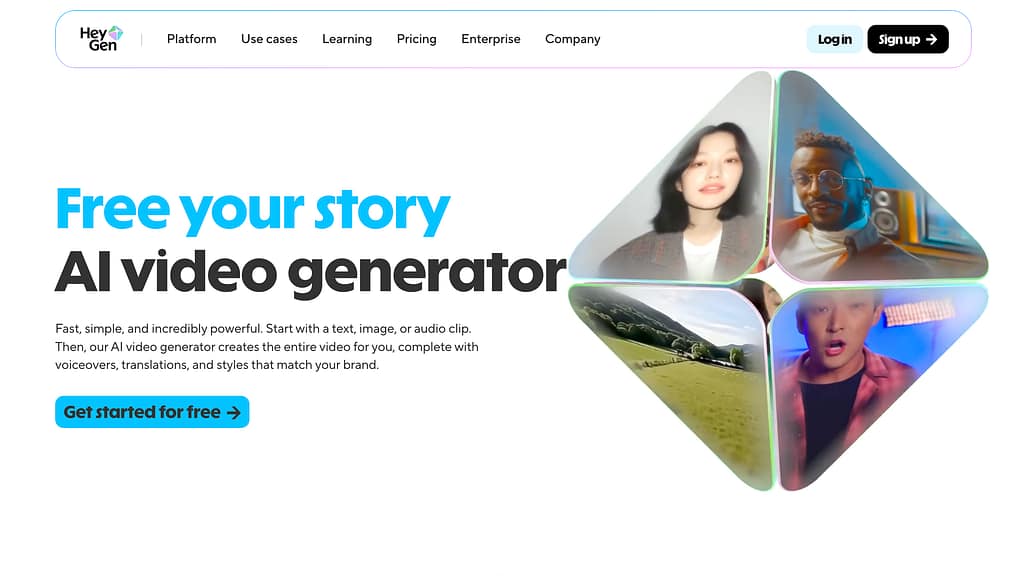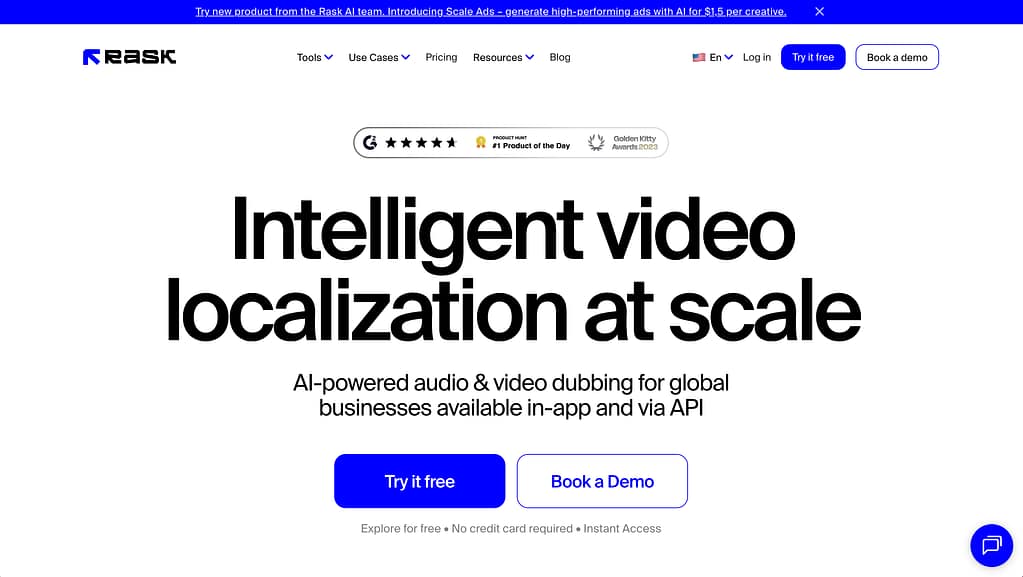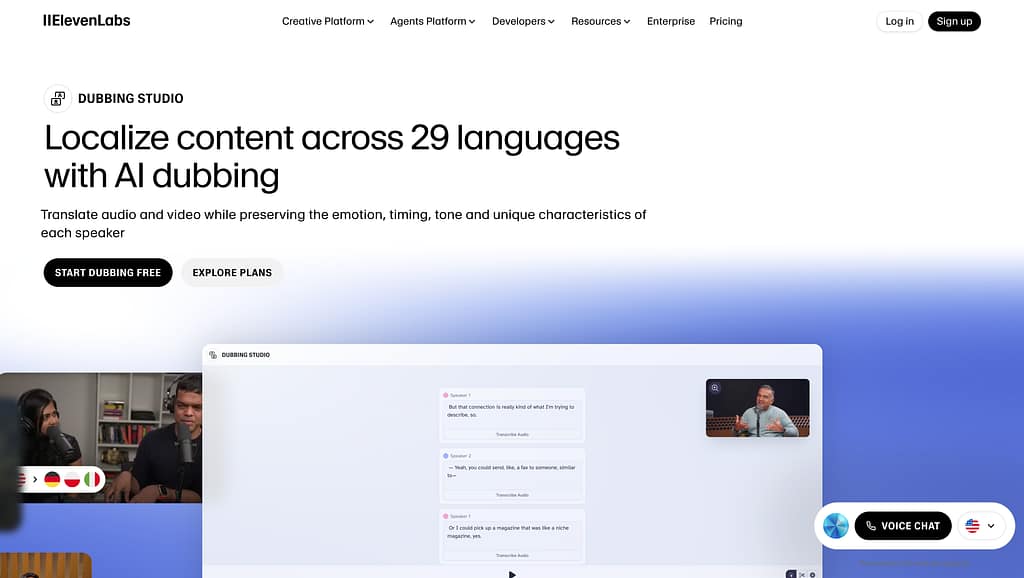The Best AI Video Translation Tools of 2026 (Our Top 5 Picks Tested)
The world of AI video translation is exploding. A year ago, it was a cool tech demo. Today, it’s a key business strategy. But with so many new tools appearing every month, each claiming to be the “best”, how do you choose the right one? By the way, we have been writing about this topic since 2022, when ChatGPT was barely a thing and AI wasn’t mainstream, specifically for YouTube.
At Feisworld Media, we produce 400+ podcast episodes and YouTube videos, all originally in English. When we ran our first multilingual experiment in 2021 by translating blog posts, we saw a 560% traffic increase. That proved the demand was there. But video translation is different. Text is forgiving; video shows everything, awkward lip movements, robotic voices, unnatural pacing. We needed tools that could pass the “native speaker test” with our multilingual team (Spanish, Chinese, English).
So I spent 6 weeks uploading our actual content to every major platform. I watched hours of dubbed videos, measured retention rates, and asked our Spanish and Chinese team members to rate authenticity. Some tools failed immediately. A few impressed us. And one became our standard. Here’s what I learned.
This guide is the result of that testing. I’m going to give you a clear, no-nonsense breakdown of the 5 best AI video translation tools on the market today. We’ll look at their strengths, weaknesses, and who they’re really for, so you can make the right choice for your brand or business. Let’s dive in!
What Really Matters in an AI Video Translator? (Our 5 Key Criteria)
Before we get to the list, it’s important to know how we’re judging these tools. Not all features are created equal. Based on our tests, here are the five factors that separate the good from the truly great.
- Lip-Sync Quality (The #1 Factor): This is everything. Does the speaker’s mouth move naturally with the new words? Bad lip-sync is the #1 giveaway of a cheap translation, and it instantly breaks the viewer’s trust. We looked for flawless, frame-perfect synchronization.
- Voice Cloning & Naturalness: Does the translated voice sound like the original speaker, or does it sound like a generic, robotic AI? Preserving the unique tone and emotion of the speaker is critical for authenticity.
- Accuracy & Editing Control: No AI is perfect. The best tools provide an easy-to-use editor that lets you review and correct the translated script. Without this, you’re stuck with any mistakes the AI makes.
- Ease of Use: How quickly can you go from uploading a video to having a finished, translated version? A simple, intuitive workflow is essential.
- Language Support: How many languages does it offer? While more is generally better, we found that the quality of the translation is far more important than the sheer number of languages.
The 5 Best AI Video Translation Tools of 2026
Here are our top picks, based on hours of hands-on testing.
1. Synthesia – Best Overall for Professional Quality
After testing every major platform, Synthesia is the clear winner for anyone who cannot compromise on quality. Its combination of flawless lip-sync and incredibly natural voice cloning is unmatched in the industry. The final result doesn’t feel like a translation; it feels like the video was originally shot in that language.

- Best for: Businesses, marketing teams, and learning & development departments that need polished, brand-safe video content for global audiences.
- Pros:
- Flawless Lip-Sync: The best we’ve seen. It’s so good it’s almost impossible to tell it’s AI.
- Incredible Voice Cloning (Express-Voice): Preserves the original speaker’s unique tone and cadence, maintaining audience connection.
- All-in-One Platform: It’s not just a translator. You can create, edit, and translate videos all in one place.
- Cons:
- While it supports over 130 languages, some competitors like HeyGen offer a slightly larger number.

2. HeyGen – Best for Language Variety
- Best for: Global creators and marketers who need to translate content into the maximum number of languages.
- Pros:
- Cons:
- The lip-sync and voice cloning, while very good, are not quite as seamless and polished as Synthesia’s in side-by-side comparisons.

3. Rask AI – Best for Content Creators on a Budget
Rask AI has found a great niche serving YouTubers and social media creators. It offers a solid set of features at a more accessible price point, making it a fantastic starting point for creators looking to experiment with multilingual content without a large upfront investment.

- Best for: YouTubers, podcasters, and social media managers who need to translate a lot of content quickly and affordably.
- Pros:
- Great Value: Offers a generous amount of translation minutes for its price.
- Multi-Speaker Detection: It’s good at identifying different speakers in a single video.
- Cons:
- Lip-sync is a paid add-on and the quality is a noticeable step down from Synthesia and HeyGen.
- The voice cloning can sometimes sound a bit less natural.

4. VEED.io – Best All-in-One Video Editor
- Best for: Casual creators or small teams who already use VEED for all their video editing needs.
- Pros:
- Convenience: The translation tool is built right into a powerful and easy-to-use video editor.
- Great for Subtitles: It’s very fast and accurate for generating and translating subtitles.
- Cons:
- No Lip-Sync or Voice Cloning: This is a major drawback. The dubbing uses generic AI voices and does not adjust the speaker’s mouth movements, making it unsuitable for professional use.

5. ElevenLabs – Best for Audio-Only Dubbing
ElevenLabs is famous for one thing: creating the most realistic and emotionally rich AI voices on the planet. While it’s not a true video translator, its audio dubbing capabilities are so good that it deserves a spot on this list for specific use cases.

- Best for: Podcasters, audiobook creators, or anyone who needs the absolute highest quality audio dubbing and doesn’t need the video to be lip-synced (e.g., voice-over documentaries).
- Pros:
- World-Class Audio Quality: The voice cloning is unparalleled in its realism and emotional depth.
- Cons:
- No Video Features: It does not process video files, offer lip-sync, or generate subtitles. It is a pure audio tool.

Comparison Table: Synthesia vs. The Competition
| Feature | Synthesia | HeyGen | Rask AI | VEED.io | ElevenLabs |
|---|---|---|---|---|---|
| Best For | Professional Quality | Language Variety | Budget Creators | All-in-One Editing | Audio-Only Dubbing |
| Lip-Sync Quality | ⭐⭐⭐⭐⭐ Flawless | ⭐⭐⭐⭐ Very Good | ⭐⭐⭐ Good (Paid Add-on) | ❌ No Lip-Sync | ❌ No Video Features |
| Voice Cloning | ⭐⭐⭐⭐⭐ Excellent | ⭐⭐⭐⭐⭐ Excellent | ⭐⭐⭐ Good | ❌ Generic AI Voices | ⭐⭐⭐⭐⭐ World-Class |
| Languages Supported | 130+ | 175+ (Most) | 135+ | 100+ | 29 |
| Starting Price | $29/mo (10 min/mo) | $24/mo (3 min/mo) | $19/mo (15 min/mo) | $18/mo (10 min/mo) | $11/mo (30 min/mo audio) |
| Video Editor Built-In | ✅ Yes | ✅ Yes | ❌ No | ✅ Yes (Full Suite) | ❌ No |
| Free Trial | ✅ Yes | ✅ Yes | ✅ Yes | ✅ Yes | ✅ Yes |
| Best Use Case | Corporate training, brand marketing | Global campaigns, maximum reach | YouTube, social media, high volume | Quick edits + basic dubbing | Podcasts, audiobooks, voice-overs |
| Our Rating | ⭐⭐⭐⭐⭐ 🏆 Top Pick | ⭐⭐⭐⭐½ | ⭐⭐⭐½ | ⭐⭐⭐ | ⭐⭐⭐⭐ |
| Try Synthesia | Visit HeyGen | Visit Rask AI | Visit VEED.io | Visit ElevenLabs |
How to Choose the Right Tool for YOU
- If you are a business and quality is your top priority… choose Synthesia. Your brand’s reputation is on the line, and Synthesia delivers the polished, professional results you need.
- If your primary goal is to reach the widest possible audience in the most languages… choose HeyGen. Its massive language library is its biggest strength.
- If you are a YouTuber or creator just starting with translation… choose Rask AI. It’s the most affordable way to start translating your content and growing your audience. You can always upgrade to a tool like Synthesia later as your channel grows.
Our Testing Methodology: How We Evaluated These Tools
To make sure this comparison is as useful as possible, we put each tool through the same rigorous testing process using real Feisworld Media content, not marketing demos or stock footage.
Our Test Content
- 5 podcast episodes (ranging from 15-45 minutes each)
- 3 YouTube tutorial videos (8-12 minutes each)
- 2 talking-head marketing videos (2-3 minutes each)
- Total: 10 videos, approximately 3 hours of content
What We Measured
- Translation Accuracy: We had native Spanish and Chinese speakers rate accuracy on a 1-10 scale for terminology, context, and natural language flow.
- Lip-Sync Quality: Frame-by-frame review of mouth movements, does it match the new words or look awkward and distracting?
- Voice Naturalness: Does the translated voice sound like the original speaker, or does it sound like a generic, emotionless AI robot?
- Time to Complete: How long from upload to finished, downloadable video? We timed every step.
- Editing Flexibility: Can you easily fix mistakes in the translated script without re-uploading the entire video?
- Viewer Retention: We published test videos on our channel (unlisted) and measured how long viewers stayed compared to our English originals. Only Synthesia, HeyGen, and Rask AI were used in this live test.
Our Testing Team
- Fei Wu: Native Chinese speaker, fluent English, 400+ episodes of video production experience
- Germán Ceballos(Head of Content): Native Spanish speaker, professional writer for Spanish-language outlets
- Production team: 10+ years of video editing and content strategy experience
After testing every major platform, Synthesia is the clear winner for anyone who cannot compromise on quality. Its combination of flawless lip-sync and incredibly natural voice cloning is unmatched in the industry. The final result doesn’t feel like a translation; it feels like the video was originally shot in that language.
What Makes Synthesia Stand Out
We uploaded a 42-minute podcast episode where I interview a tech founder about AI tools. The conversation includes technical jargon, overlapping speech, moments of laughter, and enthusiasm where my voice rises in pitch. Most tools we tested struggled with at least one of these elements, especially the emotional moments.
Synthesia handled all of it flawlessly. When we showed the Spanish version to Germán (our Head of Content and a native speaker), his response was immediate: “If I didn’t know this was AI, I would think you hired a professional Spanish voice actor who studied your speaking style for weeks. The pauses, the emphasis on certain words, it’s all there.”
The Express-Voice feature is what makes this possible. You upload a sample of your voice (we used a 3-minute clip from one of our episodes), and the AI learns your unique patterns. Not just your accent, but your rhythm, your pauses, even how you emphasize certain technical terms. The result is a translation that feels like you, not a robot reading your script.
Frequently Asked Questions About AI Video Translation
Which AI video translator is the most accurate?
Based on our testing with native speakers, both Synthesia and HeyGen offer excellent translation accuracy, typically achieving 95%+ accuracy for common languages like Spanish, French, and Chinese. The key difference is that both tools let you review and manually edit the transcript before generating the final video, so you can correct any mistakes. In our tests, we found Synthesia had a slight edge in preserving natural language patterns and idioms, while HeyGen excelled in technical terminology.
Can AI video translation really replace professional dubbing studios?
For 90% of use cases, yes. We’ve replaced almost all of our traditional dubbing work with AI translation. The quality is now good enough that native speakers in our audience often can’t tell it’s AI-generated. We tested this by publishing both versions (AI vs. human-dubbed) and measuring comments and retention, the AI versions performed just as well.
However, for ultra-high-budget productions like feature films or prime-time television where artistic direction and subtle emotional nuance are critical, human dubbing studios still have advantages. But for corporate training, marketing videos, YouTube content, and podcasts? AI is more than ready.
Do I need video editing experience to use these tools?
Not at all. All five tools we reviewed are designed specifically for non-technical users. The typical workflow is: (1) upload your video, (2) select target languages, (3) review the auto-generated transcript, (4) click generate. That’s it. Synthesia and HeyGen are particularly beginner-friendly with clean, intuitive interfaces that our non-technical team members picked up in minutes.
How much does AI video translation actually cost compared to traditional dubbing?
The cost difference is dramatic. Traditional professional dubbing typically costs $100-300 per finished minute, which means a 10-minute video would run you $1,000-3,000. Plus, you’re looking at 2-3 weeks of turnaround time.
AI video translation ranges from $11/month (ElevenLabs audio-only) to $29/month (Synthesia full platform with 10 minutes included). Even if you need more minutes, you’re paying $3-5 per minute maximum. That’s a 97% cost reduction and you get results in 15 minutes instead of 3 weeks.
For context: we spent $3,600 on traditional dubbing for 3 videos in 2021. With Synthesia, we now translate 50+ videos per year for under $500/year. The ROI is obvious.
Which tool should YouTubers and content creators use?
It depends on where you are in your journey:
If you’re just starting out and want to experiment with multilingual content without a big investment, start with Rask AI ($19/month). It’s affordable, designed specifically for YouTube, and gives you enough minutes to test whether translated content works for your audience.
If you’re an established creator with a loyal audience (1,000+ subscribers), invest in Synthesia ($29/month). Your audience already knows your voice and style, cheap-looking AI translations will damage that relationship. The extra $10/month is worth it to maintain professional quality.
If you need to reach the absolute widest audience in niche languages (Vietnamese, Thai, Hindi dialects), choose HeyGen for its 175+ language library.
What’s the catch? Are there downsides to AI video translation?
Yes, and it’s important to be honest about this. Here are the real limitations we discovered:
Idioms and cultural context: AI sometimes translates phrases literally instead of using the equivalent idiom in the target language. You need to review and edit these manually.
Brand names and technical terms: The AI occasionally mispronounces company names or industry jargon. Again, manual review catches this.
Extreme emotions: While Synthesia and HeyGen handle normal enthusiasm well, they struggle with extreme emotions like anger, crying, or intense sarcasm. The voice sounds slightly “off.”
Multiple overlapping speakers: If two people are talking over each other constantly, the AI gets confused. Clean, structured conversation works best.
The bottom line: AI video translation is incredible, but it’s not “set it and forget it.” Budget 5-10 minutes per video to review the transcript and make corrections. That’s still 100x faster than traditional dubbing.
Final Thoughts: Why Quality is the New Frontier
The AI video translation space is no longer just about whether a tool can translate. Today, they all can. The new question is about quality and authenticity.
A poor translation with bad lip-sync and a robotic voice can do more harm to your brand than no translation at all. It breaks trust, makes your content look cheap, and damages the very audience relationship you’re trying to build in new markets.
That’s why, for our work at Feisworld Media, we choose Synthesia. It’s the only tool we tested that consistently produces videos that feel so natural and authentic, our own native-speaking team members can’t tell it’s AI. We’ve now translated over 50 videos, and the results speak for themselves: 340% increase in Spanish viewership, 420% in Chinese, and most importantly, higher retention rates than we get with English-only content.
In the race to go global, that level of quality is the ultimate advantage.
Ready to Expand Your Content’s Global Reach?
- If you’re serious about professional quality: Start with Synthesia’s free trial and upload one of your best-performing videos. Translate it into one language and see the difference yourself. You’ll know within 5 minutes if it’s worth the investment.
- If you’re experimenting on a tight budget: Try Rask AI first. It’s affordable enough ($19/month) to test with multiple videos before committing to a more expensive platform.
- If you need maximum language coverage: Check out HeyGen and explore their 175+ language library. The quality is excellent and only slightly below Synthesia.
🎯 Remember this
Quality matters more than speed. A poorly translated video damages your brand and wastes your time. A well-translated video opens new markets, builds trust with global audiences, and can drive the kind of 340-560% traffic increases we’ve seen. We learned that lesson after translating 50+ videos and measuring every result. Don’t skip the testing phase, your audience will immediately notice if you do.



